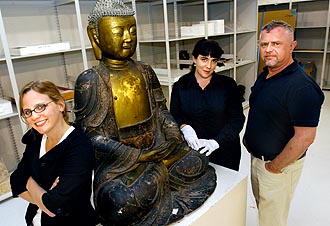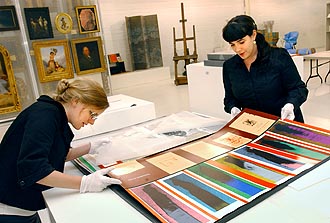Tender Loving Care for University's Art
The giant bronze Amitabha Buddha sits serenely in the middle of the Newcomb Art Gallery's off-campus storage site and art-preservation workshop space. The sculpture an example of the diverse and sometimes neglected art objects owned by the university is probably Japanese in origin and most definitely East Asian. It may date from the 18th century or earlier, says Tom Strider, interim director of the gallery and registrar of the university art collection.

Cammie Hill-Prewitt, Alexis Stahl and Tom Strider of the Newcomb Art Gallery work to preserve and document the Tulane University Art Collection, including the Buddha sculpture gracing their workshop.
Strider and staff members, Alexis Stahl and Cammie Hill-Prewitt, are like detectives on a mission to document every piece of art on campus. They are developing a comprehensive database, including information on the artists, history of the pieces and donors.
Beyond the data, though, they want to alert anyone in the university who handles art about the proper ways to preserve and protect artwork as it is displayed, stored or moved.
Stahl and Hill-Prewitt also are systematically matting all art works on paper in the university collection, using archival museum-quality boards and hinges.
The Tulane University Art Collection is under the guardianship of the Newcomb Art Gallery.
Benefactors have donated art to the university since the 1880s when the Linton-Surget family collection of French and American paintings came into Tulane's possession. A significant painting from that collection is a portrait of a Linton-Surget relative, Catharine Charlotte Surget Bingaman, by the prominent mid-19th-century portrait artist William Edward West.
"We are making a renewed effort to honor Tulane's commitment to donors," says Strider.
More than 1,500 pieces of art are stored at the off-campus storage site, but the Tulane art collection also is stored at the Newcomb Art Gallery and scattered across campus on office walls.
The Bingaman portrait, along with other works, such 19th-century neoclassical sculpture by Thomas Crawford, paintings by Carnival float designer Bror Anders Wikstrom and paintings by the mid-20th-century artist Will Henry Stevens, are "distinguished resources for Tulane," says Strider.
The art objects often are under-recognized, says Strider. "They can be better cared for and better known. And the best way to do that is for people to work together who have objects in their care."
Soon after Hurricane Katrina, the Getty Foundation approached the Newcomb Art Gallery as part of an initiative to support New Orleans' art institutions.
In response to the foundation's interest, Strider requested funding for a conservation survey of facilities housing Tulane's art collections, recognizing that the university had a clear need for outside, professional advice for improving its collections' care and management.

Cammie Hill-Prewitt and Alexis Stahl wear white gloves as they handle fragile prints in the process of preserving art works on paper.
The "Conservation Assessment" report, submitted in October and funded by a $15,000 Getty Foundation grant, suggests that as Tulane proceeds with rebuilding and renovation projects, conservation concerns should be addressed wherever art may be exhibited or stored.
In addition to the Newcomb Art Gallery and the Tulane Art Collection, the survey included the H. Sophie Newcomb College Memorial Institute and the Newcomb Center for Research on Women, Middle American Research Institute, Amistad Research Center, Latin American Library, the Tulane President's House and Special Collections of the Howard-Tilton Memorial Library.
"With conservation care, or collections management, you want to take actions that improve the conditions of the greatest number of objects," says Strider. "This document identifies what our greatest needs are."
The assessment notes the need for better lighting, storage and cataloging. The biggest concerns are for better climate control and security from theft and fire.
Strider says the assessment provides a basis for future funding and planning. He's pleased with the recommendations. "We can follow up," he says. "And we now have a better dialogue across campus."
